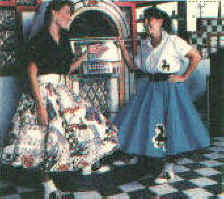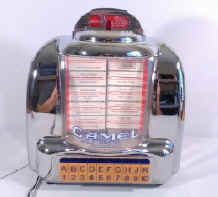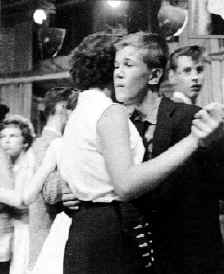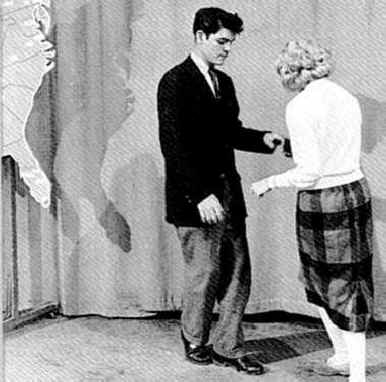Dancing in the 50s and
60s
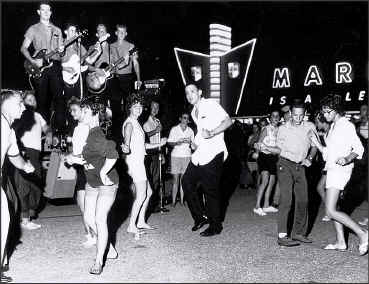
Rock and Roll dancing is actually swing dancing. East Coast
Swing, West Coast Swing, Jive and Jitterbug, all came to be known
as some type of Rock and Roll dancing, mostly thanks to the movie
industry and the general media. So in reality, the music was Rock
and Roll, and various forms of swing were used to dance to it.
From it's beginnings, rock and roll has been
associated with dancing. Teen dances in the '50s fell into two
categories: slow and fast. With slow dances couples held each
other close and moved slowly around the dance floor in a type of
box step. Fast rock and roll dances usually took the form of the
Jitterbug, a holdover from the big band swing of the '30s and
'40s. Again couples touched, if only by hand, and engaged in a
variety of fast steps that could include considerable virtuosity
and gymnastics.
The rock and roll music of the fifties was
extremely easy to dance to because it had a steady, straight
forward beat. The extraordinary uninhibited nature of the music
prompted even the most insecure or self-conscious listener to
feel they could join in on the action.
The dancing that evolved in response to
rock and roll is of black origins. The link between the music and
the movement, the music's commanding ability to make the listener
get up and dance, are a sign of its black origins.
"Neither the music, the song, nor the
dance stands alone in African-American culture"
Benita Junta Brown
While the Jitterbug has clearly traceable roots
in African-American culture, many other dances that teenagers
created to rock and roll songs during the fifties were invented
by blacks. Though whites may have popularized them, the dances
were often based on steps and body movements of blacks.
Juke Joints
Many of the places teens hung out at in the
fifties, such as ice cream parlors, bowling alleys, roller rinks
and diners had jukeboxes with the latest rock and roll records.
These jukeboxes were coin operated that played the 45 rpm records
that the teen selected. Someplaces, such as a restaurants, had a
small, compact tableside device that teens could use the select
songs to here as the waited to place their orders and/ or as they
ate. Juke joint is not to be confused by the jook joint which was
a black music and dance places that emerged just after the Civil
War, usually in the rural South.
Sock Hops
One of the places that rock and roll dancing
developed was at the local sock hop. The name was given because
dances were often held in the local school gyms. Since hard-soled
shoes weren't allowed to be worn on the gym's varnished wooden
floors, the dancers had to remove their shoes and dance in their
shoes. Thus the term became synonymous with record hops and was
widely used for any of the 50s rock and roll dance parties. It
was here that allowed the creation, observation and
practice dances. It is also why in their earliest forms dances
were highly
regionalised.
Surprisingly sock hops have
become a popular theme for modern birthday parties. Sock hop
themed decorations and a two-tier 50's poodle skirt birthday cake make for a pretty fun
party. How long does it take to bake a cake decorated like a poodle skirt?
Definitely a lot longer than it takes to learn most of these 50's
dances!
Slow Dancing
The dance they did was a slow version of the Slow
Fox Trot. Eventually fifties teens did away with almost all of
the Fox Trot's traveling figures and foot patterns. They simply
stood in place, holding tight to their partner and gently swayed
stepped forward, to the side, back and to the side in a box
pattern.
The guy put his right hand around the girl's
waist. His left hand lightly held hers at shoulder level. The
girl's left hand was on his shoulder, while her right hand
was clasping his.The guy lead going forward, while the girl
followed, moving backward.
The Fish
Mindy
Carson doing the Fish
The Fish was was an updated version of a dance from the early
1900s, the Slow Drag. in which couples would hold on the each
other and grind against each in one spot. When stepping forward
forward, the dancer was to drag the left foot. When stepping
back, it was the right foot that would be dragged. Moving
sideways to the right, the dancer would drag the left foot and
and moving sideways to the left, the dancer would drag the left
foot.
Boogie Woogie
Watch the Boogie
As a dance style, Boogie Woogie encompassed any
kind of swing dancing done fast and was also called "Jump
Swing." The Boogie Woogie was usually danced to blues and
Boogie Woogie music with fast tempos. This type of fast dancing
included jumps, hops, stomping, and even flying feet, all done at
considerable speed.
The Bunny Hop
Watch
the Bunny Hop
The Bunny Hop became a classic party dance in the
early 1950s. Originally, it was danced to the Bunny Hop by Ray
Anthony, which came out in 1952 and include all the instructions
for what to do. To do the Bunny Hop, all you need is energy to
hop away and preferably some people to form a conga line with.
Jitterbug
Watch the Jitterbug
Jitterbug is an offshoot of the Lindy Hop, a high
energy athletic dance that was started by blacks at Harlem Savoy
Ballroom in the late 20s. The dance developed in the thirties as
competing couples tried to outdo each other with more challenging
moves with awe-inspiring speed and energy. In the thirties
"jitterbug" was a term that given to the raucous swing
music fans. In the early forties, jitterbug was applied to the
modified version of the Lindy that people were dancing to the
latest swing tunes.
The Jitterbug is a spot dance meaning it does not
travel around the floor. The basic step is a syncopated two-step
that accentuates the off-beat, followed by a
"breakaway" which is the characteristic feature of the
dance. It is during the "breakaway" that the dancers
get to show off their original moves.
The Jitterbug makes use of three versions of a
six-count basic step. Though it is always in a 2/4 or 4/4 time.
The term "jitterbug" was originated in
the early '30s, and eventually, it came to be use as an umbrella
term to refer to swing in general. Movies like "Rock Around
The Clock," "Rock, Rock, Rock," and the "Girl
Can't Help It" include Jitterbug dancing in them. By the
late 1950s, youth began calling fast dancing by the name. It's
easy to learn to do the Jitterbug.
The Jitterbug Basic is counted in six counts of
music, but there are only four steps.
How to do the Jitterbug
1) Begin facing your partner with your hands clasped
gently in front of you. 2) Press into one another's hands to
propel your bodies back. 3)The lead should step back with his
left foot, while the follower steps back with her right. 4. Pull
one another's hands gently to move closer together, stepping
forward with the opposite foot. Together, steps two and three are
called the rock step. 5) The leader steps and leans to the left
while the follower steps and leans to the right. 6) The leader
steps and leans to the right while the follower steps and leans
to the left. Repeat steps two through five as many times as
desired at a pace of quick, quick, slow, slow.
The Jive
Learn The Jive
The Jive, like the Jitterbug, is a variation of
swing dancing. Its origin is American, it has strong Latin and
African American influences, and it is known for being fast and
fun. The Jive is now one of the official Latin American dance
forms in the competition arena, and it is danced the world over
in rockabilly joints.
How to do the Jive
The basic Jive dancing step consists of eight weight changes in
six beats. Whoever is leading performs a rock step (one foot step
back, other foot replace it) for the first two counts. Then, the
couple chasses to the left for counts 3 and 4. Chasse to the
right for counts 5 and 6, and then you are dancing the Jive! The
dance is simple and jovial, and it is a favorite in many American
competitions and exhibitions today.
The Cha-Cha
Learn
The Cha Cha
Originally hailing from Cuba, the Cha-Cha is
danced to many more songs than just Latin music. The basic step
is easy enough; the follower simply mirrors the steps of the
lead.
How to do the Cha-Cha
Standing in a closed dance frame, the lead steps forward
with the left foot, shifting weight onto it Immediately shift the
weight back onto the right foot, doing what's known as the
"rock step" Bring the weight back up to the left,
quickly bringing the right foot up next to the left Do another
quick weight shift to the right foot, then back to the left (this
is the "cha-cha-cha") At the original tempo, shift your
weight onto the right as it steps forward Rock back onto the
left, and bring the right foot back for another fast
"cha-cha-cha" step
Dancers repeat this basic step in between several more complex
moves that can be executed by the dancers. Like the other 50s
dance moves here, the Cha-Cha can be a dance unto itself or just
a quick move to put into any choreography where the music fits.
Hand Jive
Watch
The Hand Jive
The Hand Jive the most clear cut example of the
synchronized, choreographed dance of the fifties and perhaps the
easiest to do was the Hand Jive. The hand Jive can be done
standing up, facing a partner. standing one assumes a slightly
hunched over, bent knee position so that your thighs and
shoulders are relatively close. This also the makes it easier to
do the quick moves.
This dance was made most famous by the movie Grease. The
original song was created by Johnny Otis and enjoyed its greatest
popularity during the summer of 1958. You can see Otis singing it
on YouTube along with his dancers. While they do more complex
moves, the basic hand jive can be done using a simple jazz square
foot movement accompanied by the following hand motions:
The Hand Jive consists of a series of small gestural actions
performed in a steady rhythm, with each move falling directly on
the beat of the music.
How to do the Jive
1) Crouch down and slap your palms against your thighs twice. 2)
Cross your palms over and under each other, like a referee
announcing "safe!" 3) Make your hands into fists
and pound them on top of each other, twice each. 4) Use
your fingers to touch elbows, one at a time
"Hitch-hike" by making fists with your thumbs sticking
out and pointing them over your shoulder, again twice on each
side
The Madison Line Dance
Watch
The Madison
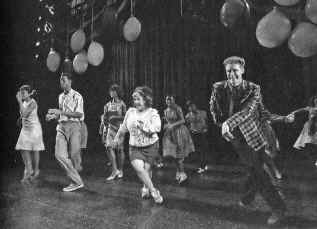
Dancing the Madison in the Broadway musical Hairspray
Photo Courtesy
Joan Marcus/Photoplay
The most intricate of the fifties choreographed group dances
was the Madison. It is generally agreed that the Madison
originated with Midwestern blacks and was appropriated by white
teens nationwide.
In the late 1950s and early 1960s, the Madison line dance gained
great popularity. A simple-to-follow dance line and steps that
were called for the dancers made it a huge success. The Madison
craze spawned several recordings of songs specifically made for
the dance with Al Brown's "The Madison" and Ray
Bryant's "Madison Time" competing neck in neck on
Billboard's Top 40. It was so popular that in 1988 the movie
Hairspray featured the dance, and it has become one of those
recurring features in movies and series depicting 1950s popular
dances.
How to do the Madison
The Madison is done in parallel, horizontal lines with
everyone facing forward. Done to music with a 4/4 meter it
consists of a six count basic step that is interspersed with
idiosyncratically variations that are preformed in response to
the caller. The basic step includes six distinct movements, each
done on one beat of the music a touch of the left foot as it
reaches diagonally across the right, a touch of the left foot out
to the left side, another touch of the left foot diagonally
across the right, a step forward on the left on the left touch, a
touch of the right foot directly next to the left and a backward
step on the right. Hand claps or finger snaps are sometimes added
on the fifth count
The Slop
Watch
The Slop
The men would put there hands in their pockets
and yank up their pants legs as if showing off their shows. It
was danced to a moderate tempo and was done without touching your
partner. basic step featuring a shoulder dip and backward
diagonal kick, as well as variations that involved swiveling on
the balls of the feet and twisting around done by crossing one
foot behind the other and making a complete turn. It wasn't
danced on Bandstand
Philadelphia Dances
Just because many new dances were introduced on Bandstand, kit
is not correct to assume that those dances were created by
Bandstand teens. Many of the Bandstand teens got a lot of there
moves, steps and styles from watching black teens. Black teen
dancing in Philadelphia could be watched on the Milt Thomas show,
often described as the black Bandstand. Originally broadcast from
Wilmington, Delaware before it moved to a studio in Suburban
Station in center-city Philadelphia, it was named after its host,
Mitch Thomas.
The Stroll
Watch
The Stroll

The Stroll, Bandstand early 59
Photo courtesy Library of Congress
One of the most popular dances of the 50s, the Stroll was a dance
popularized on American Bandstand.
The stroll was introduced on the show by Chuck
Willis. The Stroll is a group dance dance done in two parallel.
lines , with boys on one side the girls on the other, facing each
other. The basic step is a 12-count movement phrase, which is
actually a 6-count phrase simply repeated on the other side. the
boys start with the left foot, the girls with the right.
beginning with the feet together, the boy's side with a left
diagonal step ( count 1)and then with a touch of the left foot as
it drags as it drags back into place next to the right (count).
Next comes a forward diagonal step out onto to the left (count 3)
followed by a step onto the right that as it cuts tightly behind
the left (count 4) The phrase finishes with a step to the side
with the left foot (count 5) and a tough, next to it with the
right (count 6). The entire sequence is then repeated with the
right foot
The other element is the solo stroll by each
couple. While the two lines perform the basic step, a couple
formed from the boy and girl at the far end of the line ( the end
that is towards the boy's right and the girl's left) dances
together down the middle. The pair can then take the opportunity
to improvise their steps or execute a forward traveling variation
of the basic Stroll step. When the couple reaches the end of the
lane, they split apart and replace the boy and girl at the end of
the line., as a new couple forms at the opposite end.
How to Stroll
The basic move for the Stroll gradually moves the dancer, foot by
foot, up the line until he gets to the very front, at which point
the two partners abandon the basic and do their own
"shine" dance down the center aisle with everyone
clapping and appreciating them.
For Him
Step forward on your left foot. Slide your right foot up even.
Move your right foot to the right. Slide your left foot over to
meet it. Step back on your right foot.
Slide your left foot back to meet it. Move your left foot to the
left. Slide your right foot over to meet it and return to the
original position.
For Her
Step back on your right foot. Slide your left foot back even.
Move your left foot to the left. Slide your right foot over to
meet it. Step forward on your left foot.
Slide your right foot forward to meet it. Move your right foot to
the right. Slide your left foot over to meet it and return to the
original position..
The Walk
How
to do the Walk
Was done in a Conga line-like formation, with
dancers one behind another, holding on to the waist of the person
in front. It went around the room with a two-action movement
first to one side than the other. the movement involved throwing
out the same leg and arm, as the torso opened up to the side and
chugging forward slightly on the other leg as the working leg
returned to its original position
The Cha-lypso
Learn
the Chalypso
Learn How To
Cha-Lypso
The Cha-lypso was a combination of the Cha-Cha
and the Calypso. Near the end of the '50s, American Bandstand
came up with a name for the simplified Cha-Cha steps the teens
were dancing to swing rhythms: the Chalypso. While Calypso songs
were generally danced to with a mix of Rumba and Samba steps.
Somewhere down the line, it got watered down and reinterpreted as
simplified cha-cha by the youth. This fun and easy dance style
was ideal for dancing to mid-tempo swing songs - not too fast,
not too slow.
The Bop
Learn
The Bop
The Bop dance style derives from the Jitterbug
and East Coast Swing in the 1950s, but it is not to be confused
with the Bop a Lindy -based partner dance that was done by all
ages in the black community started in the 40s. The 'Bop' term
actually comes from Be-Bop, those fabulous jazzy tunes from the
'40s; however, it was not danced to Be-bop but to much faster
rockabilly, and rock 'n' roll songs of the era like those
of Gene Vincent.
The Bop was the first rock and roll dance introduced on
American Bandstand in the summer of 1957 by a visiting teenagers
from California. The Bop used many of the same moves as swing,
including partners moving around each other, but was usually done
with almost no touching and much, much faster. The Bop's more
carefree, Charleston jumpy-like moves and independent dance style
also encouraged dancers to go solo.
Dancing the bop entailed jumping up and down as
if on a pogo stick and grinding your heels into the floor each
time you landed. It's done with a partner but without holding
hands. the bop was a dance from southern California that was
being done gene Vincent's Be-Bop-A-Lula
The Philly Bop consisted of a basic jitterbug
like step with a breakaway that allowed the partners to improvise
steps. The partners stayed together musically by
maintaining the rhythm and basic step. As the dance went on there
were transistions back and forth between the basic step and the
improvisational breakaways. Hence this dance was called the Bop.
The Twist
Learn
The Twist
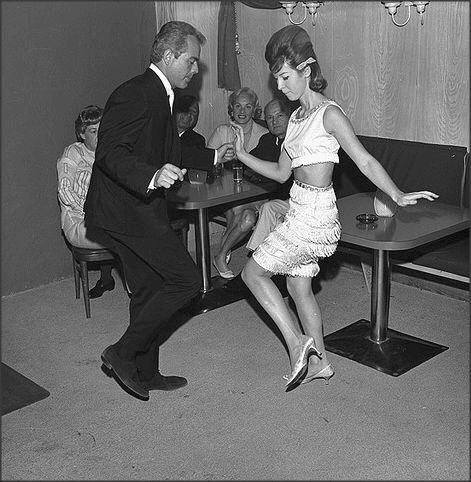
Like virtually all American dances, the Twist has
it's origins in black culture. the Twist that became that became
a sensation was an altered version of the original dance. The
Twist was actually a combination of modifications of two
earlier Ballard songs who teens danced to with torso twisting
motions. According to Ballard, the dance was derived from the
spontaneous twisting motions that his band were doing while
playing their instruments They'd Twist their bodies while they
would also lift one of their legs in the air. It was these
observations that inspired Ballard to write a song about doing
the Twist.

Buddy Deane
The dance that consisted of revolving their hips
in quick, half-circle jerks, so their pelvic regions were heaving
in time to the music. White teenagers first saw the dance
performed at a Ballard concert in Baltimore. From there they took
it to various ten dance shows among them American bandstand and
the Buddy Dean Dance Show.
There are two difference version of how Clark
became aware of the Twist. The first one was that Buddy Deane
brought it to Clark's attention. He told of how innovated it was
that the teens were dancing to it without touching their
partners. That it was sung by Rhythm and Blues singer Hank
Ballard whose songs were full of risque double entendres. Ballard
was not the type that Clark would have on his show and turned
Deane down.
In Clark's version he claims he saw a black
couple doing it on American Bandstand. He descibed what they were
doing as " revolving their hips in quick, half-circle jerks,
so their pelvic regions were heaving in time to the music."
Initially Clark would't allow it to be danced on
the show because it was "too sugggestive" for his show,
but white teenagers were fascinated by it and started imitating
it. Clark eventually gave-in to them.
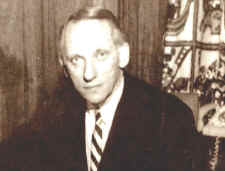
Clark thought it was 'too black' but once he
committed to promoting it he went to his friend Bernie Lowe the
owner of Cameo-Parkway Records and asked for a cover version. The
singer was to be the mild mannered, pudgy singer Ernest Evans who
Clark's wife re-named him Chubby Checker. "The Twist"
was the beginning explosion of dance oriented records.
"The Twist" is unique in rock and roll history,
becoming a #1 hit on two separate occasions (September 1960 and
January, 1962). The song and dance became a national fad,
spinning off countless twist records for Checker and others

Checker doing the Twist
Photo courtesy Photofest
Checker's Twist had no leg lifts but danced with
both feet on the ground., one slightly ahead of the other and
with knees bent. pretend you are wiping your bottom and putting
out a cigarette with both feet. some jerky movements of the arms
keeping waist level moving in opposition to your partner,
occasionally lift one arm overhead and gesturing as swing a
lasso.
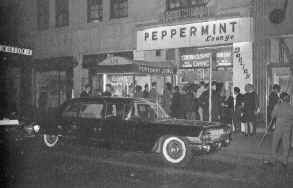
Peppermint Lounge circa 1961
photo courtesy Bettmann/CORBIS
Unlike the other rock and roll dances of
the fifties, which were signs of teen culture the Twist crossed
over to the adults. You could find it being done at
places such as the New York nightclub Peppermint Lounge. House
dancers were the Dolly Sisters who would later become better
known as the Ronettes. The House band The Starlighters contained
the core of musicians that would evolve to be come first the
Young Rascals and later simply the Rascals. There you could find
both celebrities as well as the working class doing the Twist.


